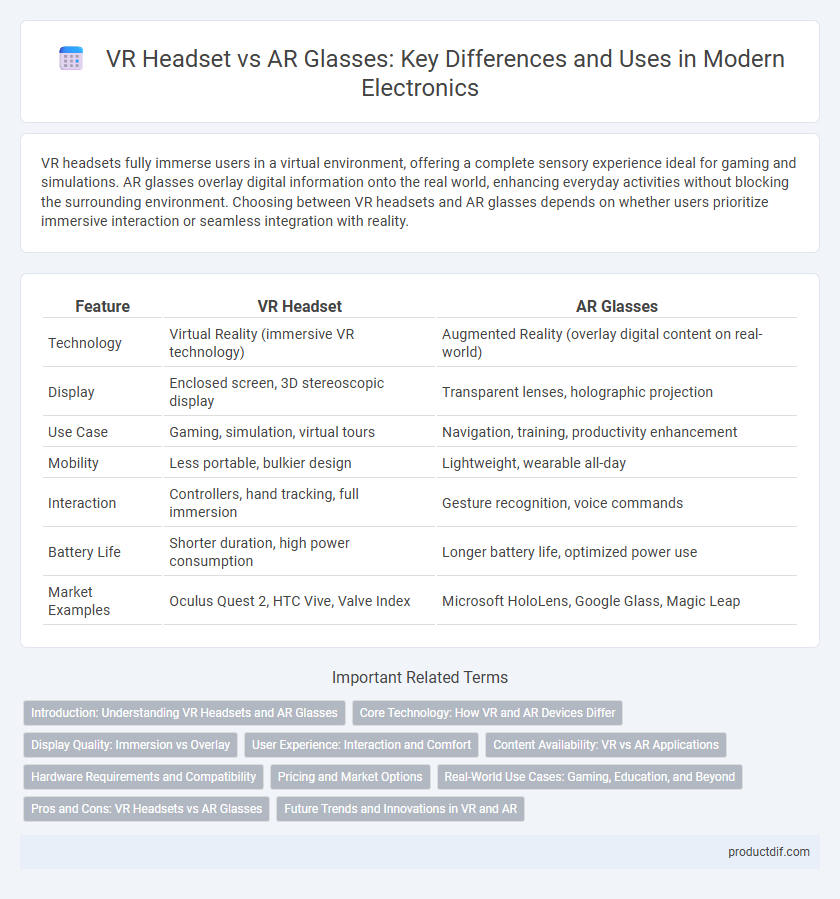VR headsets fully immerse users in a virtual environment, offering a complete sensory experience ideal for gaming and simulations. AR glasses overlay digital information onto the real world, enhancing everyday activities without blocking the surrounding environment. Choosing between VR headsets and AR glasses depends on whether users prioritize immersive interaction or seamless integration with reality.
Table of Comparison
| Feature | VR Headset | AR Glasses |
|---|---|---|
| Technology | Virtual Reality (immersive VR technology) | Augmented Reality (overlay digital content on real-world) |
| Display | Enclosed screen, 3D stereoscopic display | Transparent lenses, holographic projection |
| Use Case | Gaming, simulation, virtual tours | Navigation, training, productivity enhancement |
| Mobility | Less portable, bulkier design | Lightweight, wearable all-day |
| Interaction | Controllers, hand tracking, full immersion | Gesture recognition, voice commands |
| Battery Life | Shorter duration, high power consumption | Longer battery life, optimized power use |
| Market Examples | Oculus Quest 2, HTC Vive, Valve Index | Microsoft HoloLens, Google Glass, Magic Leap |
Introduction: Understanding VR Headsets and AR Glasses
VR headsets fully immerse users in a digital environment by blocking out the physical world and displaying computer-generated imagery. AR glasses overlay digital content onto the real world, enhancing user perception without complete immersion. Both devices leverage advanced sensors, cameras, and processors to deliver interactive and augmented visual experiences.
Core Technology: How VR and AR Devices Differ
VR headsets rely on immersive displays and motion tracking sensors to create fully virtual environments, using stereoscopic screens and gyroscopes to simulate presence in digital worlds. AR glasses incorporate transparent lenses equipped with waveguides and depth sensors, overlaying digital content onto the real world by blending virtual objects with physical surroundings. The core technological difference lies in VR's complete sensory immersion versus AR's spatial computing that enhances real-world perception through real-time contextual data integration.
Display Quality: Immersion vs Overlay
VR headsets deliver immersive display quality through high-resolution OLED or LCD screens that envelop the user's vision, providing deep contrast ratios and wide field of view for a fully virtual environment. AR glasses use transparent waveguide displays or micro-LED projectors to overlay digital content onto the real world, prioritizing brightness and color accuracy for seamless integration with natural surroundings. The key difference lies in VR's focus on total immersion versus AR's emphasis on enhancing perception through precise, context-aware visual overlays.
User Experience: Interaction and Comfort
VR headsets offer immersive user experiences through complete visual and auditory immersion, but they can cause discomfort due to their bulkiness and weight during extended use. AR glasses prioritize comfort and usability with lightweight designs and allow users to interact with digital overlays while maintaining awareness of the physical environment. Interaction in VR relies on handheld controllers or gloves for precise input, whereas AR glasses often use voice commands, gestures, and eye tracking for more natural and intuitive control.
Content Availability: VR vs AR Applications
VR headsets offer a vast library of immersive applications including gaming, virtual tours, and simulated training environments, catering to entertainment and professional use. AR glasses provide real-time contextual information overlays for navigation, industrial maintenance, and enhanced social interactions, focusing on practical, everyday applications. The content ecosystem for VR is more mature and diverse, while AR content continues to grow, emphasizing integration with real-world environments and utility-driven experiences.
Hardware Requirements and Compatibility
VR headsets demand high-performance hardware, including powerful GPUs and processors, to render fully immersive, high-resolution 3D environments with low latency. AR glasses require less intensive processing power but depend on advanced sensors, cameras, and lightweight displays to overlay digital content onto the real world seamlessly. Compatibility varies, as VR systems typically need dedicated platforms or gaming PCs, while AR glasses often integrate with smartphones or enterprise hardware via Bluetooth or Wi-Fi connections.
Pricing and Market Options
VR headsets generally range from $300 to $1,200, offering a wide selection for gaming and immersive experiences with brands like Oculus, HTC Vive, and PlayStation VR dominating the market. AR glasses often start at a higher price point, around $800 to $3,500, due to advanced sensor technology and real-world overlay capabilities, with key players including Microsoft HoloLens and Magic Leap. Market options for VR prioritize entertainment and virtual environments, while AR devices focus on enterprise applications, affecting their respective pricing structures and consumer accessibility.
Real-World Use Cases: Gaming, Education, and Beyond
VR headsets immerse users in fully virtual environments ideal for gaming experiences like Beat Saber and educational simulations such as virtual anatomy labs. AR glasses overlay digital information onto the real world, enhancing tasks in industrial training, navigation, and interactive classroom lessons. Both technologies expand real-world applications by blending entertainment, education, and professional use cases through distinct immersive approaches.
Pros and Cons: VR Headsets vs AR Glasses
VR headsets immerse users in a fully virtual environment, offering high-quality gaming and simulation experiences but often causing motion sickness and limited peripheral vision. AR glasses overlay digital information on the real world, enhancing productivity and situational awareness without isolating the user, yet they face challenges in display brightness and battery life. Choosing between VR and AR depends on the application, with VR excelling in immersive entertainment and AR preferred for hands-free, real-world interaction.
Future Trends and Innovations in VR and AR
VR headsets and AR glasses are rapidly evolving with advancements in mixed reality, AI integration, and enhanced sensory feedback, driving immersive user experiences. Future trends emphasize lightweight form factors, extended battery life, and seamless connectivity through 5G and edge computing for real-time processing. Innovations in holographic displays and spatial audio are set to blur the lines between virtual and physical worlds, expanding applications in gaming, education, and remote collaboration.
VR Headset vs AR Glasses Infographic

 productdif.com
productdif.com